Developing and Delivering the Promise of U.S. Fishery Management
Fisheries management is the effort to regulate where, when, and how people fish—protecting fish populations so that people can continue to fish in the future. NOAA's National Marine Fisheries Service is the federal agency responsible for the management, conservation, and protection of our nation's fishery resources. Through fisheries management, NOAA works to ensure that marine resources continue as functioning components of marine ecosystems, afford economic opportunities, and enhance the quality of life for the American public.
The United States has a rich history and long tradition of marine fishing, dating back to before the American Revolution. Fishermen plied their trade from near shore, south to the Antarctic, hunting fish and whales. The ocean was vast and resources seemed too plentiful to count.
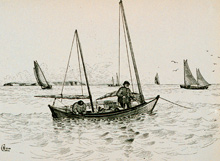
Nineteenth century fishermen handline for cod off Block Island, New York. Click image for larger view and image credit.
However, as the world turned to the sea for its wealth of natural resources, it became increasingly apparent that some management was needed. Over the years, Congress passed legislation to address specific issues, but nowhere was there a vision or a roadmap for meaningful and comprehensive marine resource management.
In 1976, Congress addressed this challenge, giving NOAA responsibility for fisheries management, and providing a comprehensive management strategy—the Magnuson Fishery Conservation and Management Act.
This article chronicles the transitions that took place in fisheries management at NOAA from 1976 to the present.
Transitions: Developing the Promise
During World War II, there was an increasing need for protein to feed American families and provide food for shipment to war zones and GIs fighting abroad. This demand was met by an increasing U.S. fishing fleet.
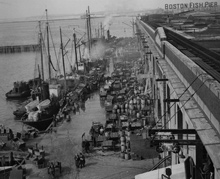
Declining harvests of New England groundfish were already apparent by the time this photo of the Boston fish market was taken in 1940. Click image for larger view.
For years after World War II, foreign fishing fleets, in increasing numbers, fished just off America’s shores, beyond the state-imposed fishing limit. These limits varied from just off shore to three, six, or nine miles from shore, according to individual state laws. At that time, there were no federal laws regarding fishing in international waters, except for some regional treaties and agreements. American fishermen were increasingly frustrated by unregulated foreign fishing and called on Congress to develop a national fishery management program.
The Magnuson Fishery Conservation and Management Act
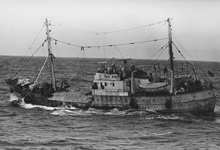
A Soviet trawler loaded with perch caught in the Pacific Ocean plies waters off America’s West coast. Click image for larger view.
In 1976, Congress worked with the states and the National Marine Fisheries Service to develop controls on fishing and put a framework in place for the scientific study and management of fisheries. These controls and framework were formalized as the Magnuson Fishery Conservation and Management Act, named after the Act’s principal author, Warren G. Magnuson (D-Washington).
In this one piece of legislation, Congress established American fishing waters (called the Exclusive Economic Zone) from state boundaries out to 200 miles from all U.S. shores, including protectorates. Foreign fishermen were no longer allowed to fish in these waters, except in certain circumstances. In addition, the Act recognized the economic, social, and environmental value of marine resources and called upon regulators to manage these finite, but renewable, resources for the long-term benefit of the nation.

In response to the 1970s discovery of immense North Pacific groundfish stocks, America closed its waters to foreign fishing.
The Act established eight regional fishery management councils to manage the fisheries in their areas of responsibility. These councils provided the private/public partnership needed for effective management. Further, the Act stipulated that the councils be composed of those most knowledgeable about the management area and that they represented the coastal states so that there would be effective coordination between state and federal fishing.

The 1976 creation of Regional Fishery Management Councils ensured involvement of constituents in fisheries management. Click image for larger view.
The Act also called for an investment in the seafood industry. Programs were developed to help fishermen improve their fishing vessels, and each region had staff devoted to promoting domestically caught seafood. As fishing activity increased, and fishing communities realized that the business of catching fish was increasingly profitable, both the number and size of the U.S. fishing fleet increased dramatically. Advances in fishing gear added to the success of catching fish.
Despite the fact that there were some areas of U.S. fisheries in trouble, for example groundfish in New England and salmon runs on the West Coast, the general belief at the time was that the ocean’s resources were unlimited. However, as American fishing capacity and technology grew, pressure on marine resources intensified. Managers began to see, from scientific studies developed to assist fishery management, declines in many of the most popular fish stocks. Fishery management, which had once worried about foreign fleets, now began to worry about the effects American fishermen were having on domestic resources.
Too Successful?
American fishermen were very successful, sometimes too successful, in capitalizing on our fisheries. Except for Alaska, most fisheries in the U.S. began to experience declines in populations. At the same time, as more and more Americans moved to the coasts, there was increasing pressure on coastal habitats. Critical marine habitats, such as mangroves and estuaries, where fish lived and/or reproduced, were developed to accommodate human activities. As a result, many habitats were destroyed or greatly diminished.

Shrimp boats docked in Bayou La Batre, Alabama, were part of the great 1970-1990 fishing boom. Click image for larger view and image credit.
In the late 1980s and early 1990s, it was becoming ever more apparent that changes were needed to reverse the direction that marine fishing had taken in the United States. Working with fishery managers in the states and federal government, Congress reworked the 1976 Act, and added tough, new requirements to enforce change and prevent fisheries from becoming depleted to the point that they could not recover.
Transitions: Delivering the Promise
Prior to 1996, there were many scientific advances and management steps taken to modify fishing practices to better estimate the actual catch of specific species. Working with the regional fishery management councils, fishery management plans were developed to reduce or redirect fishing as needed to halt overfishing and rebuild fisheries. This was necessary because the original Magnuson Act did not have the tools that were needed to meet the needs of councils and fishery managers.

NOAA Fisheries Enforcement Officers make sure that fishermen know the rules, which is one key to preventing overfishing and minimizing bycatch. Image courtesy of William B. Folsom.
At the same time, products such as the Fisherman’s Obligation Fund, originally designed to build a domestic fleet and make it competitive in the world, were reworked to make sure that they did not contribute to overfishing through overcapitalization. However, fishing was a booming business and there were many lending institutions willing to invest in the U.S. fishing fleet. There were “too many fishing boats chasing too few fish.”
In 1994, the New England multi-species fishery was closed by the Secretary of Commerce after scientists documented collapsed stocks of Georges Bank haddock and yellowtail flounder both on the bank and in southern New England, as well as a cod stock teetering on the brink of large-scale collapse similar to that already experienced in cod stocks in the North Sea and off Newfoundland. The resulting impact on the fishing community, and accompanying media attention, led to additional scrutiny on fish management activities. The attention led to a focus by Congress, environmental groups, and the fishing industry on developing more effective fishery management strategies and recovery plans.
Magnuson-Stevens Fishery Conservation and Management Act
Leaders in Congress recognized these issues and the concern of the nation’s fishing communities. Their attention led to the development of the Sustainable Fisheries Act of 1996 (also known as the Magnuson-Stevens Fishery Conservation and Management Act). The Act brought needed tools and new processes to assist NOAA Fisheries in addressing overfishing, overcapacity, and environmental concerns.
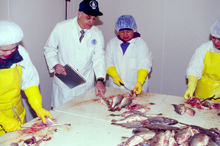
The safety of America’s seafood has been part of NOAA’s mission as the agency’s resource management responsibility has grown. Click image for larger view and image credit.
In order to give fishermen every opportunity to fish, and to meet stock rebuilding needs at the same time, many regulations within the Act became overly complex and difficult to monitor. At the same time, new regulations—and the ability to challenge them in court—led to a number of lawsuits. The lawsuits actually helped managers to design better regulations that would stand up to legal scrutiny, as well as meeting the more restrictive requirements that the refurbished Magnuson-Stevens Act had created.
These new regulations and tools were particularly difficult for the regional fishery management councils. The council’s role has always been the interface between the public, industry, and the regulators. The councils are the first to develop management plans for the agency to review and implement. Therefore, they were the first to be inundated with both work and public concern over the new directions that needed to be taken to meet Congress’ directives.
There were additional pressures on NOAA as well. NOAA needed time to digest Congress’ direction and to develop guidelines based on that direction for councils, states, and commissions to use in their deliberations.
Some of the Congressional directions were difficult to meet. Of particular concern were the rebuilding goals. In some cases, the goals were doable, but in other cases, they were not achievable in the time specified by Congress. Further compounding the issue was the warning by Congress of the importance of taking into consideration the plight of fishing communities in the stock rebuilding plans.
Progress
Since 1996, there have been more and more fishery management success stories each year. For example, the Atlantic scallop fishery has greatly benefited from the closures of the New England multi-species fishery. Scallop fishermen now harvest on a rotating crop schedule and harvest levels remain high. Likewise, Atlantic swordfish populations have been rebuilt. The Alaskan fisheries of the North Pacific, which are America’s largest and most plentiful, have been effectively managed since the beginning of management efforts.
In other areas, NOAA has not achieved the results hoped for, and in some cases, fisheries have declined. However, with effective management tools and a lot of hard work, NOAA continues to address overfishing and to rebuild fish stocks.

Gloucester, Massachusetts, is only one of many coastal communities that are struggling to retain jobs and a social fabric based on fishing. Click image for larger view and image credit.
NOAA also continues to make inroads into reducing U.S. fishing capacity, or the number of fishing vessels operating in a fishery, to balance that capacity with the amount of fish available for harvest. NOAA has developed programs that take advantage of cooperative management measures and developed a process that allows fishermen to take an active role in maintaining and rebuilding stocks by making them "shareholders." In addition, NOAA works with fishing communities to help them maintain their fishing heritage.
Some issues fall outside of NOAA’s area of responsibility; nevertheless, they affect seafood consumption and supply in the United States. For example, seafood imports have a significant effect on our economy. In addition, many activities associated with fishing negatively affect our environment. While NOAA and others have developed gear to minimize the environmental impact, it can never be eliminated. Likewise, bycatch continues to be a problem, and NOAA continues to work to find ways to reduce it. Unfortunately, bycatch will never be eliminated either.
Restructuring domestic fisheries to better meet the nation’s needs is important, but so is the strong heritage our fishing communities provide to the nation.
Conclusion
How effective has the Magnuson-Stevens Fishery Management Plan been over the past 30 years?
The Magnuson Act of 1976 brought order and direction to the American fishing industry. Fishing waters were protected for American fishermen and a domestic industry was developed. American consumers were educated and markets—and the industries dependent on them—thrived. However, we quickly learned that this natural resource was not limitless and in fact needed our help to recover from many of the fishing practices created.
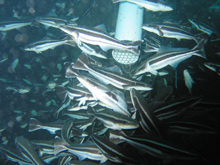
A school of Moi (or Pacific threadfin) in a Hawaiian offshore aquaculture facility. Click image for larger view.
The Magnuson-Stevens Act of 1996 sought to right these wrongs, create a management process that rebuilt fisheries to their maximum potential, and, at the same time, protected the industries that had grown up to use those fisheries. We are on that path now. As we move toward true “ecosystem approaches” to fisheries management, we will build on these successes. Aquaculture—the farming of our seas—will be a big part of a future that balances the needs of the people and communities with the responsibility of strong, science-based fishery management.
Contributed by Gordon Helm, NOAA’s National Marine Fisheries Service
